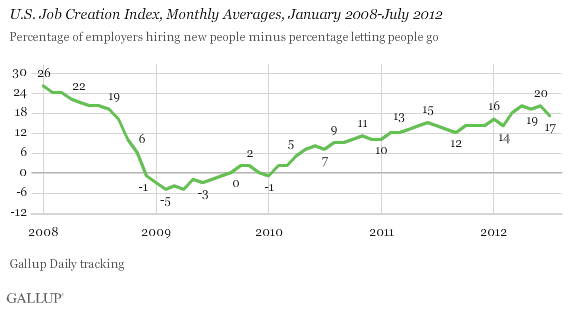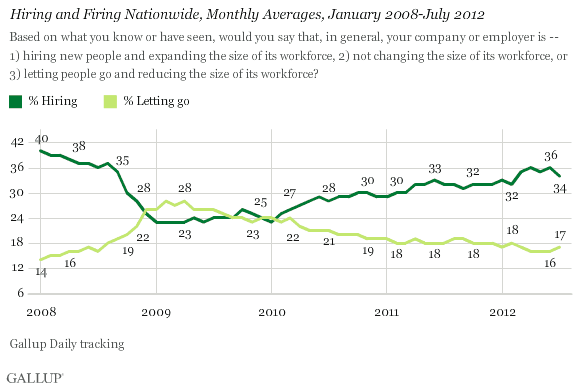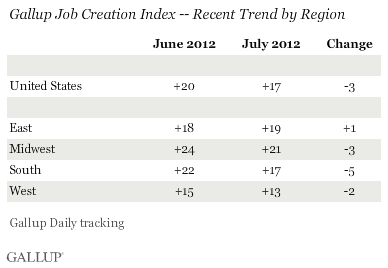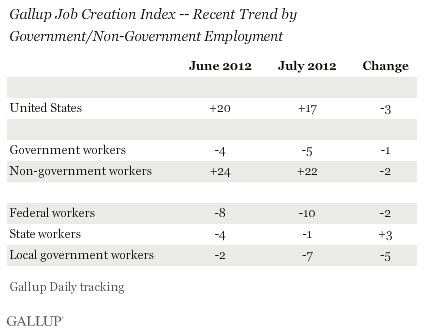PRINCETON, NJ -- Gallup's U.S. Job Creation Index slipped to +17 in July, after registering at or near +20 from April through June. Despite the drop, the +17 continues to be one of the more positive net hiring values Gallup has recorded since 2009, though it still trails the readings seen as the 2008-2009 recession was just starting.

The Gallup Job Creation Index is a measure of U.S. adult employees' perceptions of hiring conditions where they work. On average in July, 34% of all full- and part-time workers said their employers are hiring and expanding the size of their workforces, and 17% said their employers are letting workers go and reducing the size of their workforces, resulting in the +17 net hiring figure.
The hiring component of the index fell slightly to 34% in July, from 36% in June, while the firing component moved to 17%, from 16%. This backslide in hiring mirrors Americans' flagging economic confidence in July.

Hiring Remains Most Sluggish in the West
Net hiring in July remains strongest in the Midwest, now at +21, and weakest in the West, now +13, in line with the pattern seen for most of the past year.
July hiring held fairly steady in the East and West, but softened in the South and, to a lesser degree, in the Midwest.

Private-Sector Hiring Slows Slightly
Gallup's Job Creation Index averaged +22 in July among non-government U.S. workers, down slightly from +24 in June. Among government workers, the index averaged -5 in July, similar to -4 in June. Gallup has documented a significant gap between government and non-government hiring since early 2010.
Additionally, Gallup breaks down government workers by level of government. The trends on this basis indicate that local government hiring in July may have slowed more than hiring at the federal level. Hiring increased slightly at the state level. More generally, government hiring is a bit more robust at the state level than at either the local or federal level, although still below hiring in the private sector.

Bottom Line
After climbing to a roughly four-year high of +20 in recent months, the Gallup Job Creation Index gave up some of that improvement in July, slipping to +17. The decline was seen more in the South and Midwest than elsewhere, and slightly more in non-government and local government workplaces. Such dips, however, have been common in the past three years as the Gallup Job Creation Index has recovered from its 2009 recession lows. A second month of decline in August, should that happen, would be a more disconcerting economic sign.
Gallup.com reports results from these indexes in daily, weekly, and monthly averages and in Gallup.com stories. Complete trend data are always available to view and export in the following charts:
Daily: Employment, Economic Confidence, Job Creation, Consumer Spending
Weekly: Employment, Economic Confidence, Job Creation, Consumer Spending
Read more about Gallup's economic measures.
View our economic release schedule.
Survey Methods
Results are based on telephone interviews conducted as part of Gallup Daily tracking July 1-31, 2012, with a random sample of 16,314 adults, aged 18 and older, employed full or part time, living in all 50 U.S. states and the District of Columbia.
For results based on the total sample of employed adults, one can say with 95% confidence that the maximum margin of sampling error is ±1 percentage point.
Interviews are conducted with respondents on landline telephones and cellular phones, with interviews conducted in Spanish for respondents who are primarily Spanish-speaking. Each sample includes a minimum quota of 400 cell phone respondents and 600 landline respondents per 1,000 national adults, with additional minimum quotas among landline respondents by region. Landline telephone numbers are chosen at random among listed telephone numbers. Cell phone numbers are selected using random-digit-dial methods. Landline respondents are chosen at random within each household on the basis of which member had the most recent birthday.
Samples are weighted by gender, age, race, Hispanic ethnicity, education, region, adults in the household, and phone status (cell phone only/landline only/both, cell phone mostly, and having an unlisted landline number). Demographic weighting targets are based on the March 2011 Current Population Survey figures for the aged 18 and older non-institutionalized population living in U.S. telephone households. All reported margins of sampling error include the computed design effects for weighting and sample design.
In addition to sampling error, question wording and practical difficulties in conducting surveys can introduce error or bias into the findings of public opinion polls.
For more details on Gallup's polling methodology, visit www.gallup.com.
